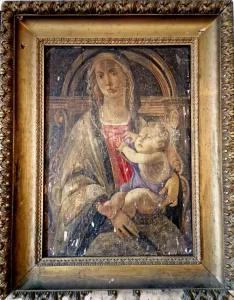Often, when I write about a rediscovered long-lost masterwork, the person who had it often had no idea that they owned such a rare, valuable work by a great master. However, when Italian authorities seized a painting from a southern Italian family last week, the owners seemed to know exactly what it was: a €100 million Botticelli painting.
Sandro Botticelli’s Madonna & Child is a tempera on panel painting, also sometimes called the Madonna delle Grazie, named after the church of Santa Maria delle Grazie where it was originally kept. Some specialists speculate that the Virgin Mary’s likeness is that of one of Botticelli’s favorite models, the Italian noblewoman Simonetta Cattaneo Vespucci, who also appears as the titular goddess in Botticelli’s magnum opus, The Birth of Venus. There are two popular theories about how the Madonna ended up in a small provincial church outside Naples. The first proposed provenance is that of the art historian Ronald Lightbown, whose biography and catalogue of Botticelli’s life and work is still one of the defining monographs of the artist. According to Lightbown, Botticelli originally gifted the work to Pope Sixtus IV around 1470. However, it soon found its way to Santa Maria delle Grazie, in Santa Maria la Carità, just outside Naples. Lightbown posits the pope did this because the Medici family owned the church and other properties in the area. Therefore, the painting was likely gifted to this small church so the pope, strapped for cash, could strengthen ties with the powerful Florentine banking family. At the time, Sixtus IV was trying to raise funds to build a papal chapel at the Vatican. Though initially called the Great Chapel, later generations called it the Sistine Chapel, named after the pope who had built it. The second theory on the painting’s origins is that of Raffaello Causa, who positively attributed the work to Botticelli in the 1960s while serving as superintendent of the Gallerie della Campania. According to Causa, the Madonna was likely commissioned not by the papacy but by the King of Naples, Ferdinand I. It then found its way to a church in the countryside since much of the land surrounding Naples belonged to the king’s friends and advisors.
In 1982, Santa Maria delle Grazie sustained damage in an earthquake. The church moved some of its treasures out, entrusting them to local families. The Somma family received the Madonna delle Grazie. However, while the church was undergoing repairs, people seemed to have forgotten all about the Botticelli. However, some interest in the painting got kicked up again because the Carabinier renewed its efforts to retrieve it earlier this year. The painting’s transfer was peaceful, with Gragnano’s mayor acting as an intermediary to ensure that the Somma family handed over the work. The Carabinieri, the force that amounts to Italy’s cultural police, took possession of the painting, citing the requirement to guarantee the work’s safety.
Indeed, the painting is not in the best condition. Some of the paint has flaked off, while what remains is very faded. Some of the paint, both original as well as touch-ups, has also oxidized over the centuries. If specialists could effectively restore the painting, reversing hundreds of years of past deterioration and repairs, it is unknown to whom the painting would be returned. Technically, the family was looking after the painting on behalf of the church, given a certificate of transfer that gave them rights as the painting’s custodians. However, while the church would normally have the right to reclaim the work, the damage Santa Maria delle Grazie suffered during the earthquake was enough to close it. Therefore, the Carabinieri’s Massimiliano Croce stated that the Botticelli’s ownership might revert to the Italian state should the Somma family fail to provide proof of legitimate ownership. Restoration is expected to take about one year, after which it will be exhibited at a museum in Naples.

